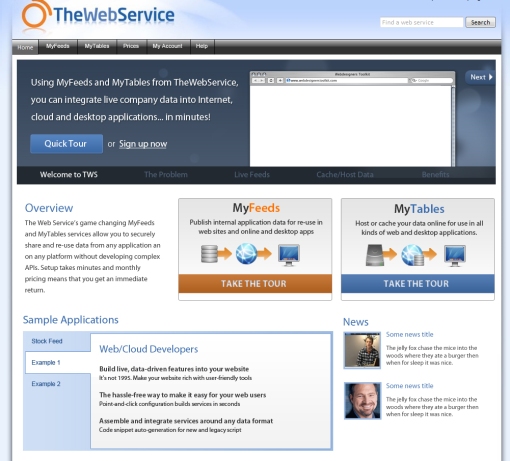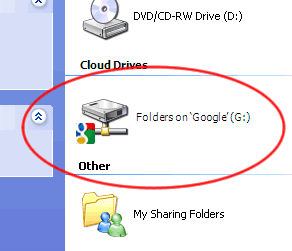Data as a Service can empower your business, or help you develop great web apps quickly and easily.

Not everybody believes in the validity of the term “data as a service,” but these opinions seem to be held mostly by academics and niche bloggers who are resistant to “yet another –aaS acronym” (which is understandable, I guess). There is still no entry for the term DaaS on Wikipedia.
But whatever you want to call it, the vendors who are leading the charge for this kind of functionality – data on tap as and when you need it, priced affordably – are calling it DaaS, and as far as I’m concerned, they offer the service so they make the rules. Here’s my top 5, unranked:
StrikeIron

http://www.strikeiron.com/
I believe StrikeIron coined the term “Data as a Service,” positioning itself as a supermarket for data. It seems to me that since CEO David Linthicum (link) left the data reseller has lost its way a little – it seems to offer less datasets than it once did – but this may be a sign of the recession and the huge cost that some of these data providers charge for a standard licence. However they still offer a raft of data and claims its IronCloud platform is “the only comprehensive Web services Delivery Platform that opens up new channels for data distribution and consumption through Web services.”
Jigsaw
 http://www.jigsaw.com/
http://www.jigsaw.com/
Jigsaw is a bit of an unknown factor at the moment. It’s managed to garner quite a bit of interest through its collaborative infrastructure, “open source” credentials and its mission to “map every business on the planet.” This is worth a look, though it’s nowhere near the size and scope of Dun and Bradstreet’s formidable database. What is interesting is that D&B recently announced an alliance of sorts with Jigsaw, with intention to pull Jigsaw’s 12-million-strong contact database into its own 140-million-business-strong records. In this respect Jigsaw has a fairly limited scope as a DaaS company (and I suspect that even its core offering of a complete company contact database will be one puzzle that’s never finished). Nonetheless, what it’s doing and the way it’s going about it is very interesting indeed.
Postcode Anywhere
 http://www.postcodeanywhere.com/
http://www.postcodeanywhere.com/
Postcode Anywhere has a somewhat misleading name for those outside the US (no, they don’t physically post people code, postcode is Britspeak for zipcode). They started in 2000, essentially building auto-fill web services around addressing data and reselling the functionality and data on. The company now offers a far wider range of services than its name suggests, including demographic profiling and route optimisation. What’s interesting is the company is constantly adding to its portfolio of services, so it truly isn’t “just” an address auto-fill company any more, building other data services on its award-winning platform. It is also bringing cloud computing to government with services like AL2Anywhere, a lightweight but powerful GIS tool.
The Web Service
 http://www.thewebservice.com/
http://www.thewebservice.com/
Cloud expert David Linthicum recently blogged about TheWebService’s innovation in the arena of Data as a Service. The website is about to undergo a radical change from going the StrikeIron route of “data marketplace” to being a developer-centric hub where users can upload their own data and build web services around it. This is similar to Caspio’s offering; developers can upload their data in Excel or CSV format and TheWebService will host it (this is called “MyTables”). What’s more interesting, though, and what Linthicum noted recently, is the ability to securely bypass your company’s firewall and build web services around *live* data, pumping it from your local machine and through TheWebService’s interface, with auto-generated code making it easy to build web services around your own live data.
TheWebService will be showing off a redesign soon (first pre-release design below) and anyone looking to beta-test the service should email philr@thewebservice.com.
Caspio
 http://www.caspio.com/
http://www.caspio.com/
Caspio Bridge is very similar to TheWebService’s MyTables offering, with blogger Bill Ives commending its “flexibility, power, and ease of use.” Network World says it is “polished, performs well, and is competitively priced.” A system designed so you can build web services around your own data, it might not be as technologically accomplished as TheWebService (there is no functionality for building services around dynamic data) it’s certainly easy to get a handle on what they’re offering. Fees are fixed monthly bills, with different caps on the data transfer, according to the pricing plan, as opposed to TheWebService’s pay-as-you-go rates, so users have a choice there too.
In conclusion…
These top 5 all have something different to offer the cloud developer who wants to build in some extra functionality to their website or app. The beauty about Data as a Service is that the price of getting data into the end-user application is typically very low indeed; as companies embrace cloud computing these new ways to empower business quickly, easily and affordably offer a shining light at the end of the tunnel of recession. It’s not just Amazon, Google and Microsoft’s Azure that are making the enterprise cloud interesting. I’m affiliated with Postcode Anywhere and TheWebService, so I know all about the cool stuff they have to offer – and through research/experience I know of a few others – but if you have any more DaaS vendors you’d like to see in an updated blog post just email them to me and I’ll put them on a new list soon.
New design for TheWebService website…

As you can see there will be more of an emphasis on developers hosting their own data, as well as the many benefits of MyTables and MyFeeds. It’s not finished yet (as the placeholder “jellyfox” text indicates) but it should make it a lot easier for developers to get to grips with TWS’s powerful functionality. Remember, it will be open for beta testing soon so email philr@thewebservice.com to get on board.







 http://www.jigsaw.com/
http://www.jigsaw.com/ http://www.postcodeanywhere.com/
http://www.postcodeanywhere.com/ http://www.thewebservice.com/
http://www.thewebservice.com/ http://www.caspio.com/
http://www.caspio.com/










